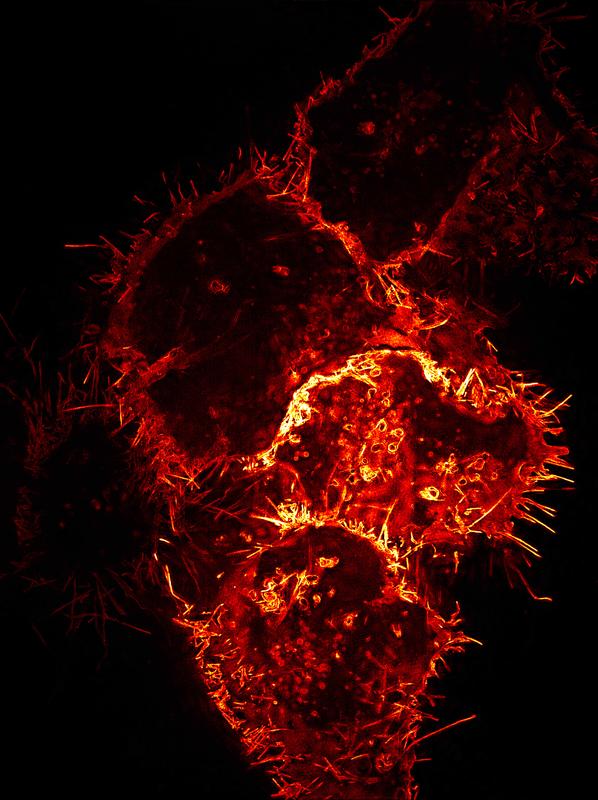Viral decoys – how the Ebola virus leads the immune system astray

Human cells that produce virosomes. For this, the cells were manipulated so that they pro-duce fluorescently labeled Ebola envelope protein. This is incorporated into the cell membranes and released as virosomes. These have a size of about ten thousandths of a millimeter and were visual-ized via high-resolution microscopy. University Hospital Tübingen
As reported by the team led by the Tübingen virologist Prof. Michael Schindler, the glycoprotein of the Ebola virus causes cells to release small vesicles bearing the Ebola virus glycoprotein on their surface. These so-called virosomes bind antibodies directed against the Ebola virus glycoprotein and could thereby interfere with control of viral infection by the antibody response.
In addition, the virosomes suppress the release of cytokines and chemokines by macrophages. Macrophages are scavenger cells that release messenger molecules and thereby coordinate the immune responses against invading viruses.
Why do most patients mount an immune response against Ebola virus despite the release of virosomes? Again, the virologists have an explanation: “The immune system has developed countermeasures against virosomes,” explains Schindler.
“We were able to show that another cellular protein, which plays an important role in innate immune defense, can prevent the release of virosomes.”
The newly discovered properties of virosomes are of importance for basic research. In addition, they have implications for therapy and prevention. “The virosomes apparently carry functionally intact Ebola glycoprotein on their surface, but are otherwise not infectious,” explains Prof. Stefan Pöhlmann, co-author of the study and head of the Infection Biology Unit at the German Primate Center in Göttingen. “This makes virosomes attractive candidates for vaccine development.”
The researchers now want to investigate whether other hemorrhagic fever viruses also release virosomes and whether they can be used for the production of vaccines.
Caption: Human cells that produce virosomes. For this, the cells were manipulated so that they pro-duce fluorescently labeled Ebola envelope protein. This is incorporated into the cell membranes and released as virosomes. These have a size of about ten thousandths of a millimeter and were visual-ized via high-resolution microscopy.
University Hospital Tuebingen
Institute of Medical Virology and Epidemiology
Prof. Dr. med. Michael Schindler
Head Molecular Virology of Human Infectious Diseases
Elfriede-Aulhorn-Str. 6, 72076 Tuebingen, Germany
Tel. +49 (0)7071 29-87459
Michael.Schindler@med.uni-tuebingen.de
Release of immunomodulatory Ebola virus glycoprotein-containing microvesicles is suppressed by tetherin in a species-specific manner.
Authors: Julia Nehls, Ramona Businger, Markus Hoffmann, Constantin Brinkmann, Birgit Fehrenbacher, Martin Schaller, Brigitte Maurer, Caroline Schönfeld, Daniela Krämer, Stephan Hailfinger, Stefan Pöhlmann, Michael Schindler
DOI-Nummer: https://doi.org/10.1016/j.celrep.2019.01.065
Media Contact
More Information:
http://www.medizin.uni-tuebingen.de/All latest news from the category: Life Sciences and Chemistry
Articles and reports from the Life Sciences and chemistry area deal with applied and basic research into modern biology, chemistry and human medicine.
Valuable information can be found on a range of life sciences fields including bacteriology, biochemistry, bionics, bioinformatics, biophysics, biotechnology, genetics, geobotany, human biology, marine biology, microbiology, molecular biology, cellular biology, zoology, bioinorganic chemistry, microchemistry and environmental chemistry.
Newest articles

First-of-its-kind study uses remote sensing to monitor plastic debris in rivers and lakes
Remote sensing creates a cost-effective solution to monitoring plastic pollution. A first-of-its-kind study from researchers at the University of Minnesota Twin Cities shows how remote sensing can help monitor and…

Laser-based artificial neuron mimics nerve cell functions at lightning speed
With a processing speed a billion times faster than nature, chip-based laser neuron could help advance AI tasks such as pattern recognition and sequence prediction. Researchers have developed a laser-based…

Optimising the processing of plastic waste
Just one look in the yellow bin reveals a colourful jumble of different types of plastic. However, the purer and more uniform plastic waste is, the easier it is to…



